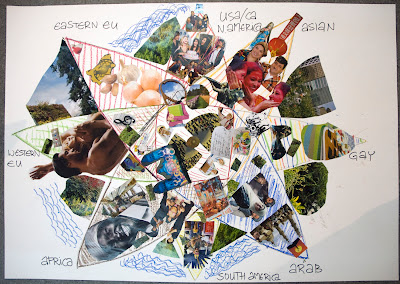SOFIA – 5 JUNE 2010
An impression of the Moscow Workshop - click on a photo to view the album
PARTICIPANTS 14
Danubians: Tanja Bubic, and Thijs van Velzen
Jury: Stanka Jeleva – artist (Sofia)
Adrian Vela - artist (Sofia)
Stefan Krastev – Red House (Sofia)
Tanja Bubic – Danube Foundation (Amsterdam)
URBAN COLORAMA - THE UTOPIAN CITY OF EUROPE
Veronika Tzekova, Ema Yordanova, Lidia Kamenova, Milen Staykov
Motivated, planned, build, and inhabited according to the segmented choices of social networks. The Utopian City of Europe will be one big urban structure composed of sub cities shaped by interest and needs.
All sub cities are defined by people’s specific interest or characteristics, i.e. sport, age, industrial production, gaming, arts. All sub cities will have its own administrative and social services core. People can switch between sub cities, but the related constrains, its social and physical structures of each sub city should be accepted. Represented by a radiator the Utopian City of Europe radiates heat and comfort.
Maria Baleva, Valentin Denkov, Martin Angelov
Christina Mitovska, Biliana Baeva, Martina Koleva, Gradinko
Yanina Taneva, Nikola Venkov, Alexander Marinov
The Danube Foundation organized the Utopian City Workshop at the Red House in Sofia on the 5th of June 2010.
All sub cities are defined by people’s specific interest or characteristics, i.e. sport, age, industrial production, gaming, arts. All sub cities will have its own administrative and social services core. People can switch between sub cities, but the related constrains, its social and physical structures of each sub city should be accepted. Represented by a radiator the Utopian City of Europe radiates heat and comfort.
CHOICE
Maria Baleva, Valentin Denkov, Martin Angelov
The city as a reflection of its inhabitants tries to show the contrast of two completely different worlds separated by a river. The concept represents the fundamental divide between good and bad, between right and wrong. The first city SinSofia is a city of restriction where everybody inhabits his capsulated space in an artificial environment. This city has potentials, which are hidden behind boundaries. The city on the other side of the river is an open city, which allows its inhabitants the freedom to choose and involves nature in our daily life. People from both worlds are crossing the river from one to the other place. The city makes it clear that people are responsible for their own choices. Its configuration forces people to make a choice.
BLOSSOM CITY
Christina Mitovska, Biliana Baeva, Martina Koleva, Gradinko
Blossom City solves the problem of immigration of different cultures. Each petal of the city represents a certain ethnic/lifestyle group. The further away from the centre you go, the more culturally defined life is. It becomes more homogeneous towards the periphery. People are able to move from petal to petal, because identity is not regarded as a given. Towards the centre cultures mixes. All education takes place in the city centre, so people live with their peers but study and perform public functions in a shared multicultural space. Blossom City also comprises a vertical structure where conflicts between the various minorities can be sorted out, without inflicting physical and emotional damage.
MAHALA (wins)Yanina Taneva, Nikola Venkov, Alexander Marinov
Mahala gives everyone the opportunity to build their house in their own way using sustainable, nature friendly materials in order to stimulate creativity and independence of all citizens. The city is organized in Mahalas, in ‘neighborhoods’ of two types, which offer housing in blocks as well as family houses. They can be local communities, with a high level of social cohesion. The cityplanning does not provide any infrastructure for cars, since Mahala is off-territory for cars, because everything lies within walking distance. Walking is stimulated by the layout of the city. Every Mahala is centred around a cultural core, where galleries, cinemas, museums, etc. are located. People can travel from Mahala to Mahala by a air-metro. Energy sufficiency can be considered another fundamental aspect of Mahala. Solar panels provide most of the required energy. The bond between man and nature is always kept in mind.
The Danube Foundation organized the Utopian City Workshop at the Red House in Sofia on the 5th of June 2010.







